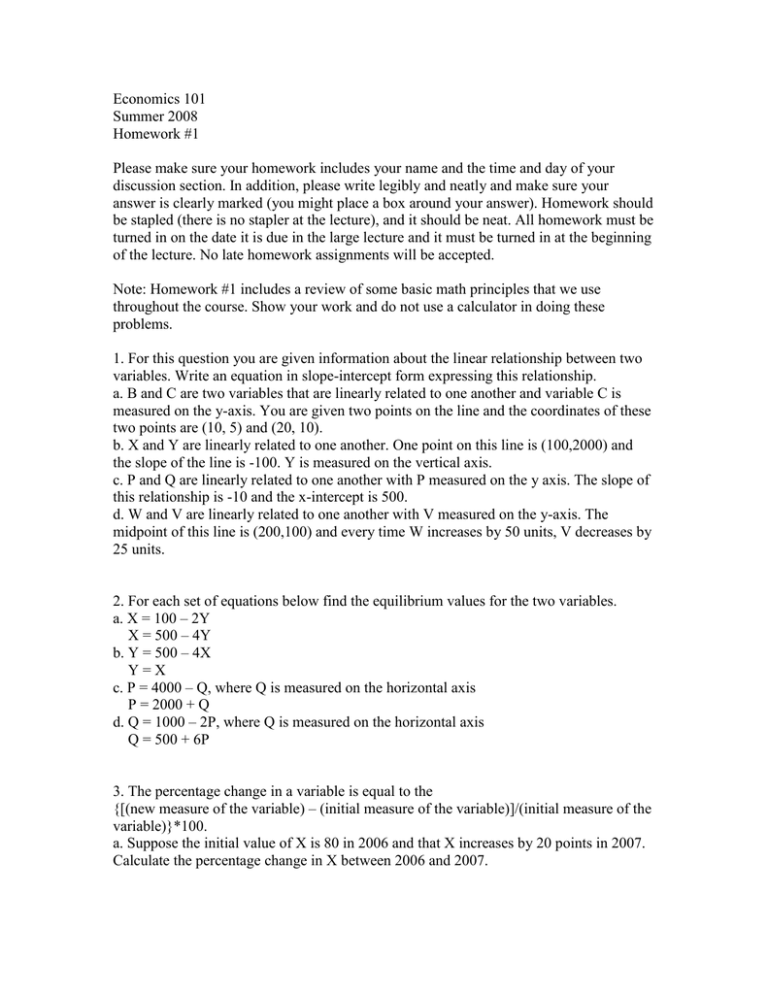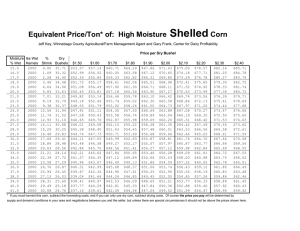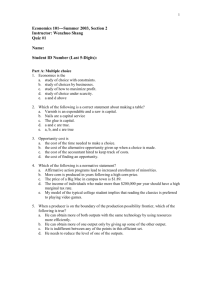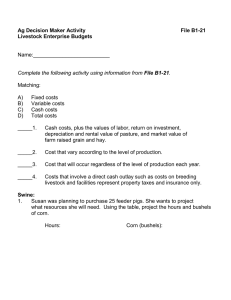Economics 101 Summer 2008 Homework #1
advertisement

Economics 101
Summer 2008
Homework #1
Please make sure your homework includes your name and the time and day of your
discussion section. In addition, please write legibly and neatly and make sure your
answer is clearly marked (you might place a box around your answer). Homework should
be stapled (there is no stapler at the lecture), and it should be neat. All homework must be
turned in on the date it is due in the large lecture and it must be turned in at the beginning
of the lecture. No late homework assignments will be accepted.
Note: Homework #1 includes a review of some basic math principles that we use
throughout the course. Show your work and do not use a calculator in doing these
problems.
1. For this question you are given information about the linear relationship between two
variables. Write an equation in slope-intercept form expressing this relationship.
a. B and C are two variables that are linearly related to one another and variable C is
measured on the y-axis. You are given two points on the line and the coordinates of these
two points are (10, 5) and (20, 10).
b. X and Y are linearly related to one another. One point on this line is (100,2000) and
the slope of the line is -100. Y is measured on the vertical axis.
c. P and Q are linearly related to one another with P measured on the y axis. The slope of
this relationship is -10 and the x-intercept is 500.
d. W and V are linearly related to one another with V measured on the y-axis. The
midpoint of this line is (200,100) and every time W increases by 50 units, V decreases by
25 units.
2. For each set of equations below find the equilibrium values for the two variables.
a. X = 100 – 2Y
X = 500 – 4Y
b. Y = 500 – 4X
Y=X
c. P = 4000 – Q, where Q is measured on the horizontal axis
P = 2000 + Q
d. Q = 1000 – 2P, where Q is measured on the horizontal axis
Q = 500 + 6P
3. The percentage change in a variable is equal to the
{[(new measure of the variable) – (initial measure of the variable)]/(initial measure of the
variable)}*100.
a. Suppose the initial value of X is 80 in 2006 and that X increases by 20 points in 2007.
Calculate the percentage change in X between 2006 and 2007.
b. Suppose the value of X in 2007 is 100 and that X decreases by 25% in 2008. Calculate
the value of X in 2008.
c. Suppose P decreases by 10% while Q increases by 100%. The initial values of P and Q,
respectively, are 10 and 100. What are the new values of P and Q?
4. The following table describes the production possibility frontier (PPF) for 2008 for
Littleton, a community that produces two goods, food and clothing, from its available
resources and technology. Assume Littleton’s PPF is linear between the points listed in
the table.
Points on Little’s PPF
Food (Pounds of Food)
Clothing (# of Items)
A
0
1000
B
100
950
C
400
750
D
600
450
E
700
100
F
725
0
a. Draw a graph of Littleton’s PPF for 2008 based on the information in the above table.
In your graph, measure food (F) on the vertical axis and clothing (C) on the horizontal
axis.
b. Suppose Littleton is currently producing at point C on their PPF. What is the
opportunity cost to Littleton of producing one additional unit of food?
c. Suppose Littleton is currently producing at point C. What is the opportunity cost of
producing one additional unit of clothing?
d. Suppose Littleton is currently producing at point E. What is the opportunity cost of
producing 25 more units of food?
e. Suppose Littleton is currently producing at point E. What is the opportunity cost of
producing 650 more units of clothing?
f. Does Littleton’s PPF illustrate the Law of Increasing Opportunity Cost with regard to
food production? Explain your answer.
g. Does Littleton’s PPF illustrate the Law of Increasing Opportunity Cost with regard to
clothing production? Explain your answer.
h. For each of the following combinations of (C, F) identify whether the combination is
on Littleton’s PPF, lies inside Littleton’s PPF, or lies beyond or outside Littleton’s PPF.
Explain your answer.
i. (1050, 20)
ii. (800, 125)
iii. (725, 300)
iv. (400, 550)
5. Roger and Marie both like home cooked meals and hand knit sweaters. Suppose that
Roger and Marie have the same amount of time to devote to each of these pursuits and
that they currently do not trade with one another. The table below provides information
about the maximum amount of meals and sweaters Roger and Marie can produce if they
use all of their resources to produce either meals or sweaters. Assume that Roger and
Marie’s production possibility frontiers are linear.
Home Cooked Meals
Hand Knit Sweaters
Roger
20
10
Marie
16
6
a. Who has the absolute advantage in producing meals? Who has the absolute advantage
in producing sweaters?
b. What is Roger’s opportunity cost of producing one additional sweater? What is
Roger’s opportunity cost of producing one additional meal?
c. What is Marie’s opportunity cost of producing one additional sweater? What is Roger’s
opportunity cost of producing one additional meal?
d. Suppose Roger and Marie decide to specialize and trade. What good should Roger
specialize in producing? Explain your answer.
e. Suppose Roger and Marie decide to specialize and trade. What good should Marie
specialize in producing? Explain your answer.
f. What is the range of prices in terms of sweaters that one meal will trade for if Marie
and Roger specialize?
g. What is the range of prices in terms of meals that one sweater will trade for if Marie
and Roger specialize?
6. Sarah and Renee produce clothing and food. The table below provides information on
the number of hours of labor that a unit of clothing or a unit of food takes Sarah or Renee
to produce. Assume that Sarah and Renee use only labor to produce clothing and food.
Assume that the production possibility frontiers for both Sarah and Renee are linear.
Hours of Labor Needed to
Hours of Labor Needed to
Produce One Unit of
Produce One Unit of Food
Clothing
Sarah
4
2
Renee
3
2
a. What is the opportunity cost of producing one unit of clothing for Sarah?
b. What is the opportunity cost of producing one unit of food for Sarah?
c. What is the opportunity cost of producing one unit of clothing for Renee?
d. What is the opportunity cost of producing one unit of food for Renee?
e. Suppose Sarah and Renee decide to specialize and trade with one another. What good
should Sarah specialize in producing? Explain your answer.
f. What is a range of prices in terms of food that one unit of clothing will trade for if
Sarah and Renee specialize and then trade with one another?
g. Will Sarah be willing to trade three units of food for 7/3 units of clothing? Explain
your answer?
h. Will Renee be willing to trade five units of clothing for 7 units of food? Explain your
answer?
7. Sweetland and Grassland both produce wheat and corn. Assume there are no inherent
problems with either country producing only wheat or only corn. In addition, assume that
Sweetland and Grassland have linear production possibility frontiers with respect to these
two goods. Furthermore, assume that currently Sweetland and Grassland do not trade
with each other. Two points on Sweetland’s production possibility frontier are 200
bushels of corn and 300 bushels of wheat, and 400 bushels of corn and 100 bushels of
wheat. Two points on Grassland’s production possibility frontier are 400 bushels of corn
and 0 bushels of wheat, and 300 bushels of corn and 300 bushels of wheat. Current wheat
and corn production for these two countries is given in the table below.
Corn Production in Bushels
Wheat Production in
Bushels
Sweetland
300
200
Grassland
300
300
Total Production
600
500
a. Write an equation in slope intercept form for Sweetland’s production possibility
frontier. Assume wheat is the y variable.
b. Write an equation in slope intercept form for Grassland’s production possibility
frontier. Assume wheat is the y variable.
c. Which country can produce wheat at lowest opportunity cost?
d. Which country can produce corn at lowest opportunity cost?
e. The two countries decide to specialize and then trade with one another. Neither country
fully understands the comparative advantage argument so they decide they will simply
negotiate with each other a given level of corn production and then produce whatever
amount of wheat they can produce with their remaining resources. They decide that
Sweetland will produce 50 more bushels of wheat while Grassland will produce 50 less
bushels of wheat. Fill in the following table based upon this production decision and the
assumption that both countries will continue to produce on their production possibility
frontiers.
Corn Production in Bushels
Wheat Production in
Bushels
Sweetland
Grassland
Total Production
f. Does specialization and trade increase the total level of production of these two
countries according to your calculations in part (e)? Discuss your findings.
g. The two countries decide to specialize and then trade with one another. Neither country
fully understands the comparative advantage argument so they decide they will simply
negotiate with each other a given level of corn production and then produce whatever
amount of wheat they can produce with their remaining resources. They decide that
Sweetland will produce 50 fewer bushels of wheat while Grassland will produce 50 more
bushels of wheat. Fill in the following table based upon this production decision and the
assumption that both countries will continue to produce on their production possibility
frontiers.
Corn Production in Bushels
Wheat Production in
Bushels
Sweetland
Grassland
Total Production
h. Does specialization and trade increase the total level of production of these two
countries according to your calculations in part (g)? Discuss your findings.



